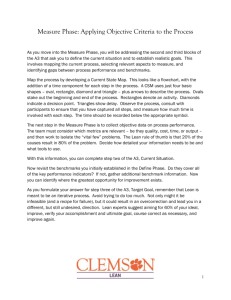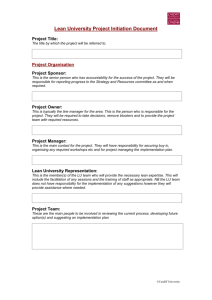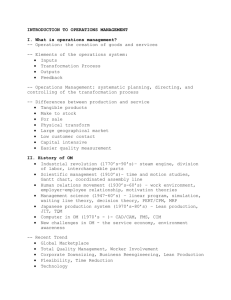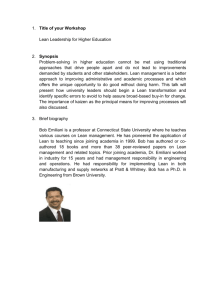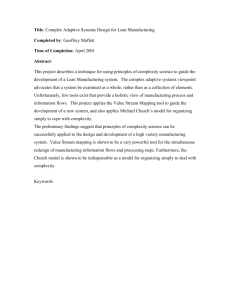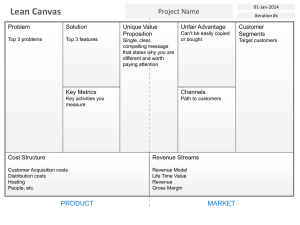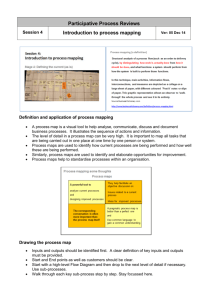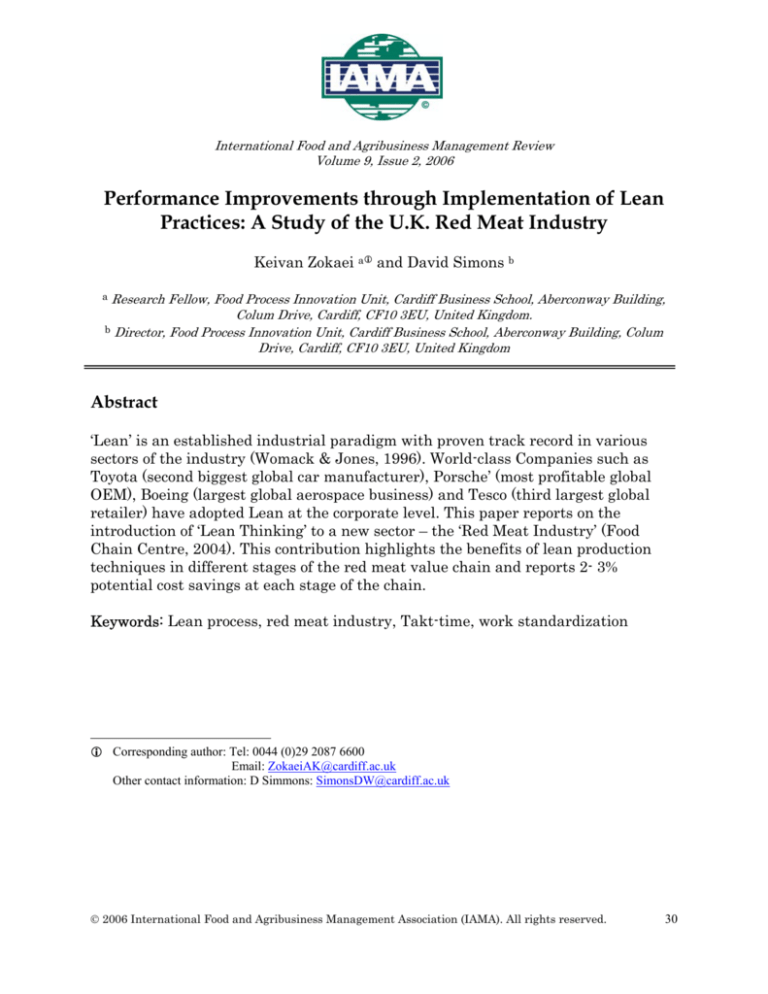
International Food and Agribusiness Management Review
Volume 9, Issue 2, 2006
Performance Improvements through Implementation of Lean
Practices: A Study of the U.K. Red Meat Industry
Keivan Zokaei aL and David Simons b
a
Research Fellow, Food Process Innovation Unit, Cardiff Business School, Aberconway Building,
Colum Drive, Cardiff, CF10 3EU, United Kingdom.
b Director, Food Process Innovation Unit, Cardiff Business School, Aberconway Building, Colum
Drive, Cardiff, CF10 3EU, United Kingdom
Abstract
‘Lean’ is an established industrial paradigm with proven track record in various
sectors of the industry (Womack & Jones, 1996). World-class Companies such as
Toyota (second biggest global car manufacturer), Porsche’ (most profitable global
OEM), Boeing (largest global aerospace business) and Tesco (third largest global
retailer) have adopted Lean at the corporate level. This paper reports on the
introduction of ‘Lean Thinking’ to a new sector – the ‘Red Meat Industry’ (Food
Chain Centre, 2004). This contribution highlights the benefits of lean production
techniques in different stages of the red meat value chain and reports 2- 3%
potential cost savings at each stage of the chain.
Keywords: Lean process, red meat industry, Takt-time, work standardization
L Corresponding author: Tel: 0044 (0)29 2087 6600
Email: ZokaeiAK@cardiff.ac.uk
Other contact information: D Simmons: SimonsDW@cardiff.ac.uk
© 2006 International Food and Agribusiness Management Association (IAMA). All rights reserved.
30
Zokaei and Simons / International Food and Agribusiness Management Review Volume 9, Issue 2, 2006
Introduction
Nearly a hundred years ago Henry Ford drew upon the Chicago slaughterhouses’
carcass disassembly (break down) processes to build the world’s first assembly flow
production line at Highland Park plant, Detroit (Hounshel, 1984: 241). Ford’s flow
method of production led the global economy into an era of ‘production for masses’,
away from crafts production techniques (Ibid). The key underpinning characteristics
of Ford’s system were inter-changeability of assembly parts, inter-changeability of
labor, and high degree of vertical integration and control across the supply chain.
The main building block of Ford’s system of production for masses was the interchangeability of the assembly parts (a problem which never existed in the
disassembly of an animal carcass). In this sense, Ford was indebted to the pioneers
of the American System of Production, especially Eli Whitney of Pratt and Whitney
Co. (Chandler, 1977). The second most important attribute of Fordism was the
standardization and fragmentation of all tasks on the shop-floor (Littler, 1985). Jobs
at Ford required limited skills and were as interchangeable as the assembly parts.
An army of narrowly trained workforce (largely immigrants who barely spoke
English and in fact needed not to communicate since tasks were very
straightforward) worked in the Ford’s plants. Ford incentivised this tightly
controlled – unskilled – labor, to vigorously perform these simple repetitive jobs,
through higher wages (the famous five dollar day) (Hounshell, 1984: 259). Finally,
Henry Ford’s dedication for uninterrupted flow of material led him to establish
various parts and raw materials supplier plants adjacent to the assembly line. At
the River Rouge plant, Ford literary produced everything required to make a car –
from oilseed crops to steel mills to power plants (Hounshell, 1984).
Such articulate system of ‘production for masses’ well-suited the manufacture of
identical Model-T’s offering the company the economy of scale which in turn enabled
it to constantly lower the prices. Nonetheless, the markets soon became saturated
with the monotonous Model-T’s and many customers turned to General Motor’s
automobiles for a perception of individuality, style and quality (Hounshell, 1984:
267). Ironically, the prosperity that ‘production for masses’ brought to American
society created ever more demanding customers that sought for the customized
products of the flexible mass production era. Another force that added to Ford’s
challenge was the emergence of the worker unions, during the 1920’s demanding for
better life-style in return for their tedious jobs (Hounshell, 1984).
By 1925, GM had yearly model-change policy. At Chevrolet, Khudson – a former
chief production engineer at Ford – had devised a relatively flexible production
system which – to some extend – accommodated change. Khudson radically
departed from Ford Production System by deploying general purpose production
machinery as opposed to single purpose machine tools. Although, Khudson stuck
with the Ford’s idea of sequenced manufacturing line, kept large amounts of
© 2006 International Food and Agribusiness Management Association (IAMA). All rights reserved.
31
Zokaei and Simons / International Food and Agribusiness Management Review Volume 9, Issue 2, 2006
inventory between the work stations to compensate for the changes (Hounshell,
1984: 265). Hence, Chevrolet became the birthplace of what is today known as ‘Mass
production’ and can be characterized with its batch and queue mode and mountains
of work-in-progress. Eventually, in 1927, after a significant slump in market shares,
Henry Ford, had to succumb to the principles of mass production. GM’s marketing
creed had triumphed over pure production of Ford (Hounshell, 1984: 267). And so,
the smooth flow of identical components evolved into mass production – for many
product variants.
Eventually, Toyota resolved this contradiction by developing a flow production
system for many product variants and became the birthplace of lean production
(Womack et al, 1990). According to Mann (2002), powerful business solutions don’t
accept trade-offs; one Lean philosophy is to eliminate the non-value adding
compromise between uninterrupted flow of the process and market-oriented flexible
production. Lean production contrasts mass production, by emphasizing the
importance of smooth flow, continuous improvement and employee empowerment
(Womack & Jones, 1996). This paper explains the various aspects of lean production
and reports on introduction of some Lean practices across several Red Meat supply
chains. The two basic lean techniques discussed in this paper are Takt-time (Ohno,
1988) which is the basis for smooth continuous production flow, and standardized
work (Imai, 1997) which is the basis for continuous improvement.
Literature Review
The UK Red Meat Industry in Context
Agriculture in Europe and North America is heavily supported by government
intervention and protected by trade barriers. In Europe, the Common Agricultural
Policy (CAP) supports via import tariffs and subsidy payments. Nonetheless, the
market trends are towards eradication of the global trade barriers; and following
the ‘Agenda 2000 Agreement’1, (CAP-reform), the EC’s CAP budget is undergoing
major reform. The admission of former Eastern Block states, penetration of cheap
meat suppliers (e.g. EU full tariff beef imports increased from 26,000 tonnes to
94,000 tonnes between 2000 and 20042), and consumer behavioral changes in favor
of convenience and organic products challenge the red meat industry across Europe
(Gower, 2004). Over and above that, there have been several issues specifically
challenging the UK red meat industry, i.e. the BSE3 disease epidemic during the
1990’s, outbreak of Foot and Mouth disease in 2000/2001, and concentration of
The Agenda 2000 agreement was agreed upon in Berlin in March 1999. It helps European
agriculture to meet the challenges of future trade liberalisation. For more information see:
www.defra.gov.uk/farm.
2 Source European Commission
3 Bovine Spongy Encephalopathy commonly known as Mad Cow disease
1
© 2006 International Food and Agribusiness Management Association (IAMA). All rights reserved.
32
Zokaei and Simons / International Food and Agribusiness Management Review Volume 9, Issue 2, 2006
market power in the hands of multiple retailers (in the UK the top four retail chains
account for nearly two thirds of the retail meat sales) (Fearne, 1998; Simons et al,
2003; Hornibrook & Fearne, 2001; Tarrant, 1998). Support payments in the UK
have hitherto been on a headage (per head of livestock) basis; but from January
2005, payments cease on a productivity or headage base. Instead, producers will
receive a single-farm payment based on historic claims and/or land area. Pre-2005,
in order to secure a headage support payment, producers could make a rational
decision to produce animals at a loss against the global prices. The decoupling of the
support payments increases producers need to minimize supply costs, and may lead
to rapid rationalization of the industry. One of the key solutions, proposed in the
literature, for smoothing the process of rationalization in the industry is the pursuit
of best available practices and creating a learning environment where companies
continuously strive on improvement (Pickernell & Hermyt, 1999; Simons & Zokaei,
2005). Clearly, Lean Thinking is one approach that offers insight into potential
opportunities for improvements and best available techniques. Against this
background, this paper shows the potential benefits which can be realized through
implementation of some Lean practices across the supply chain.
Lean Thinking
The term ‘Lean’ was first coined by James Womack, Daniel Jones and Daniel Roos
in “The Machine that Changed the World” (Womack et al, 1990). Lean production is
rooted in the Toyota’s Production System which turned ‘Toyota Motor Corporation’
from a small domestic producer in 1950’s into one of the world’s leading automotive
companies in the 1980’s. The tenet of ‘lean’ production is elimination of waste both
within the firm and across the supply chain (Womack & Jones, 1996). The notion of
waste elimination dates back to the ‘Scientific Management’ movement (Taylor,
1914; Gilbreth, 1911) in America and has been the cornerstone of all business
paradigms which focus on the productive rationality of capital (being human,
financial or manufactured capital). Scientific Management (Taylorism) rationalizes
the use of labor-power at the individual worker level – through fragmentation of
individual jobs into different tasks and optimization of each (Ibid). Fordism, adopts
the rational principles of Taylorism and extends the focus of waste elimination to
the whole process (Doray, 1988: 69). The Fordist flow assembly line – for the first
time – made it possible to control the quantity of effort required at the individual
workstations through setting an average line speed (the factory clock speed).
Similarly, Mass Production has been defined as a ‘ruthless war on waste’ (Filene,
1925: 88). Yet, Lean’s definition of waste is quite distinctive from Taylorism,
Fordism or that of Mass production. Taiichi Ohno (1988), the father of Toyota
Production System, defined Waste (Muda4) as any human activity, which absorbs
resources but creates no value. Performing a wasteful activity adds no value but
incurs cost. Ohno (1988) identifies seven types of Muda: waste from overproduction,
4
Muda is Japanese for waste, futility and purposelessness.
© 2006 International Food and Agribusiness Management Association (IAMA). All rights reserved.
33
Zokaei and Simons / International Food and Agribusiness Management Review Volume 9, Issue 2, 2006
waste from waiting inventories, waste from unnecessary transport, waste from
waiting times, waste from unnecessary motion (movement of people), waste from
unnecessary processes, and waste from defected products.
Both Taylorism and mass production have been criticized for causing ‘alienation of
the labor’ (Doray, 1988: 116). It is true that there is a degree of ‘work abstraction’
(Marx, The Capital) in lean – due to standardization of the work methods and
sequence, and not allowing for self-regulation of the work speed. Nonetheless, lean
avoids total estrangement of the workers through broadening the scope of jobs,
offering task variety, eliminating tight supervision, reducing the need for
inspections, and encouraging social interactions in workplace (see Womack and
Jones, 1996). Contrary to the ‘sword of Damocles’ approach of the western automanufacturers Toyota empowered employees and guaranteed jobs for life, which in
turn allowed Toyota to benefit from full-hearted participation of employees.
Womack and Jones (1996) propose a set of principles for achieving a lean enterprise.
Companies should embrace these principles and incorporate them into their
operations, sequentially. Integrating these principles into operations entails use of
certain tools and techniques. Here, the lean principles are briefly explained and
then two lean techniques (Takt-time and operations standardization) are discussed
in more depth. The first principle of lean is identification of value from the endconsumer’s perspective. The second lean principle (value stream) is identification of
product families or services that follow common process paths to the consumer. The
third principle of lean is ‘flow’ – a single product should continuously flow through
value-creating processes without interruptions or intervals. The fourth principle is
to only let value flow at the pull of the customer. ‘Value flowing at the pull of
customer’ implies that nothing is produced upstream unless someone down stream
demands for it. This is opposite of ‘batch and queue’ thinking which suggests mass
production and large inventories in advance and based on forecasted demand. The
last principle of lean production is pursuing perfection continuously. This means
that firms should always look for waste and find new forms of it and tackle it.
(Womack & Jones, 1996)
Nowadays, companies such as Xerox not only apply the lean principles to their own
operations but find substantial benefits in implementing Lean Thinking in their
customers’ processes (Xerox, 2005).
Lean Transformation in the Agri-business Sector
The Food Value Chain Analysis Approach
At the heart of any lean transformation lies the reengineering of the value chain
(being a single firm or part of the supply chain) to implement the principles of ‘flow’
and ‘pull’ (Womack and Jones, 1996; Rother and Shook, 1999). This paper reports
© 2006 International Food and Agribusiness Management Association (IAMA). All rights reserved.
34
Zokaei and Simons / International Food and Agribusiness Management Review Volume 9, Issue 2, 2006
on part of the findings from an extensive research program, which looked into eight
red meat value chains in three countries. The research team deployed an agribusiness specific Lean implementation methodology – the Food Value Chain
Analysis (FVCA). The methodology embraces a number of prominent Operations
and Supply Chain Management paradigms, namely Value Stream Mapping (Rother
and Shook, 1999; Hines and Rich, 1997), Efficient Consumer Response (Seifert,
2003) and Value Chain Analysis (Porter, 1985; Shank and Govindrajan, 1988).
Using the FVCA nine chains in three years were studied and – in excess of – forty
middle and senior managers from across the supply chain were trained on Lean
thinking tools and techniques to apply them in the participating firms.
The notion that key processes across the supply chain form a Value Chain and the
method of analyzing the value chain for competitive advantage was introduced by
Professor Porter (1985) of Harvard Business School. Subsequently, Value Chain
Analysis was developed in the management accounting literature (Shank, 1989;
Shank and Govindarajan, 1993; Coopers and Lybrand, 1996) and more recently in
the operations management literature (Rainbird, 2004). The Food Value Chain
Analysis is a structured method of analyzing the effects of all the core activities on
cost and/or differentiation of the value chain; FVCA analyses where in the supply
chain the wastes can be reduced or differentiation can be enhanced (Zokaei and
Simons, 2005). The essence of this method is generating a systematic map of the
value chain and a systematic method of analyzing each strategic activity in relation
to the consumer’s value (i.e. the first principle of lean thinking). A key attribute of
FVCA is that its analysis and metrics are based on determinant attributes such as
quality and time, not on financial attributes. The advantages proposed for this
approach are that determinants are leading indicators of financial performance, and
from a change management perspective determinant measures are more easily
shared across company boundaries (Simons et al, 2003).
A Typology of the Lean Elements – Philosophies, Policies and Practices
Based on some previous research (Macduffie, 1995; Macduffie & Pil, 1996; Pil &
Macduffie, 1996; Hines 2001), this paper suggests that the success of lean
production stems from a combination of practices, policies, and philosophies. Figure
1 demonstrates a typology of lean elements. Successful lean implementation
involves amalgamation of various elements from different levels in Figure 1. For
example, Just-in-Time inventory management policy and creation of smooth flow go
hand in hand while both depend on the introduction of Takt-time in practice.
Furthermore, companies which implement single piece flow need to promote the
workers’ participation policy and pursue continuous improvement philosophy to
sustain the flow production system within the organization.
Figure 1 underlines the fact that lean production goes beyond the operational level
and links into the overall business philosophy of the organization. That is, lean
© 2006 International Food and Agribusiness Management Association (IAMA). All rights reserved.
35
Zokaei and Simons / International Food and Agribusiness Management Review Volume 9, Issue 2, 2006
Lean Philosophies
Waste Elimination,
Striving on perfection,
Kaizen, (Continuous
incremental
improvements)
Systemic Processual
Approach,
Lean Policies
TPM, Co -operation
and transparency
in S.C., Visual
Control, Poka -Yoke
Fewer suppliers,
Enhanced employee
participation
Focus on
Consumer Value
Lean Practices
Standardized work, Takt-time,
5S, Kanban
Level production
Autonomation
Figure 1: Typology of Lean Elements – Philosophies, Policies and Practices
Adapted from (Simons and Zokaei, 2005)
production is more than just a set of tools and techniques. ‘Lean Thinking’ restores
the organizational focus on the real ‘value’ (i.e. value from the customer’s point of
view) and aligns all the processes to that end. Nonetheless, the existing paper only
focuses on application of lean practices to different stages of the red meat supply
chain. The objective of this paper is to appraise the benefits of two lean practices
(standardized operations, Takt-time) along the chain, and quantify the potential
benefit to all stakeholders.
Takt-Time
The German word ‘Takt’ means precise cycle of time, rhythm or interval; it, also,
refers to the conductor’s baton and beat of music. The term ‘Takt’ was first
introduced in the German aircraft industry, and subsequently was taken to Japan
by the German engineers training Japanese aircraft producers pre-World War II,
and later became an integrated element of lean production (Wada, 1995). Takt-time
is used to synchronize the rate of the production process with the customer demand
in order to prevent the waste of overproduction (Rother and Shook, 1999). Takt is
the time elapsed between units of output, when the production rate is synchronized
to customer demand. According to Ohno (1988) calculating Takt-time shows when
items are needed so that they are produced as required, one-by-one.
© 2006 International Food and Agribusiness Management Association (IAMA). All rights reserved.
36
Zokaei and Simons / International Food and Agribusiness Management Review Volume 9, Issue 2, 2006
The most significant source of Muda (waste) is overproduction, i.e. producing more,
sooner or faster than is required by the next process downstream (Rother and
Shook, 1999). Overproduction means that resources are tied up in stock rather than
being directly devoted to production. Buffer inventories are often costly to store and
handle, hinder move from one product design to another and hide production errors.
Thus, by avoiding overproduction, Takt is central to lean production.
Takt-time is calculated by dividing the customer demand into available working
time per shift. The calculation for Takt-time is as follows:
Takt-time =
Production Time Available *
Customer Demand * *
* Total production time minus breaks, downtime, etc. It includes changeover time. Sometimes regarded
as Operational Availability
** Average customer demand over a certain period
When the Takt-time for a process is 30 minutes, it means that the process should
produce only one part per 30 minutes. This is totally different from producing 2
parts per hour or 16 parts in an eight-hour shift. This links into one-piece flow
production – the third principle of lean production (Miltenberg, 2001). In order to
achieve one piece per 30 minutes, each processing step along the production line
should precisely perform its task within 30 minutes and pass the work-piece down
the process.
The simplicity of the Takt-time concept belies its astonishing effects. Here are some
main features of a Takt system.
Increased Productivity through Stabilized Production Flow
Flow production was first introduced in 1913, when Ford Motor Company setup the
first flow assembly line for the Magneto assembly process (Hounshell, 1984). This
was a major breakthrough in the static mode of assembly and increased
productivity by 50% (from twenty man-minutes down to thirteen man-minutes).
However, a problem soon occurred: the rate of the work flow was not constant.
Shortly, Ford engineers found that by moving magnetos at a set rate by means of a
motorized chain, they could set the pace of work. This resulted in a four fold
increase of productivity: five man-minutes compared to the original twenty
(Hounshell, 1984). Cleary, the concept of Takt or stabilized flow logically follows
from the concept of ‘flow’. It has been understood that smoothness and harmony in
flow are fundamental to productivity and efficiency (also see the case of aircraft
industry and one hour bomber Kidder 1995). The Takt system describes a constant
rate of flow.
© 2006 International Food and Agribusiness Management Association (IAMA). All rights reserved.
37
Zokaei and Simons / International Food and Agribusiness Management Review Volume 9, Issue 2, 2006
The production flow, theoretically, can have a constant or a variable rate. A flow
line with variable flow rate, for example between 0.75 and 1.25 units per minute on
different occasions; but averages 60 units per hour. On the contrary, a constant rate
line runs at 1 unit per minute throughout the hour. Operating to a Takt-time means
all workstations operate at a constant rate synchronized to the customer demand.
By eliminating variability at each step, Takt-time prevents build-ups of inventory
between workstations and the stops and starts that occur at a variable flow rate.
Work Balance
Work Balance refers to a situation where all the operators along the production line
require the same length of time to perform their tasks. Operating a line to Takttime is a prerequisite to effective work balance. In an ideal situation, the work
content is distributed evenly between workstations in a way to meet the Takt-time
(Tapping & Fabrizio, 2001). Figure 2(a) is an illustration of an unbalanced line
where cycle-times vary significantly from one process step to another (cycle-time for
a work station is the time required from completion of one unit to completion of the
next5). Operator 4 is pressurized to cut corners in order to finish the job within the
(a)
(b)
Figure 2(a): In the first illustration (left) the production line cannot make the
necessary quantity because operation number 4 exceeds the Takt-time. In the
second chart (right), the work has been balanced at Takt-time or slightly below.
(Source: Strategos, 2004)
Figure 2(b): This figure illustrates improved balance of the line; work content is
nearly balanced and the cycle-times are just below the Takt-time. Line balance
creates a situation where individual and team performance can be monitored. This
has potential benefits and drawbacks for operators (Babson, 1995). Benefits
included good ergonomics and increases morale since everyone works equally hard.
5
Cycle time is a measured quantity and takt time is a calculated value.
© 2006 International Food and Agribusiness Management Association (IAMA). All rights reserved.
38
Zokaei and Simons / International Food and Agribusiness Management Review Volume 9, Issue 2, 2006
Takt-time, while operators 1, 6 and 7 drag their heels. Line imbalance potentially
impairs the quality, leads to underutilized machinery and people, builds up
inventory levels, causes individual frustration, and triggers team dissension.
On the other hand, the rigidity of Takt-time means that operators cannot take
informal unscheduled breaks (Delbridge, 1998).
Enhanced Awareness on Performance
Takt-time is displayed on the shop floor, sometimes using electronic devices, which
count back from the Takt-time to zero in every cycle. So, production team tracks
time and “everyone can see where production stands at each moment” (Womack &
Jones, 1996). This provides frequent and cyclic feedback on productivity, machine
reliability and quality problems, which increases the level of awareness in both
workers and management. Such heightened awareness brings great motivation to
the team and leads to higher productivity and quality.
Standardized Work Practices
Operations standardization began with the ‘Scientific Management’ movement
(Taylor, 1914; Gilbreth, 1911) as the first step towards the modern industrial era
and as a method of reducing dependency on the skilled workers of the craft
production age. According to Imai (1997), work standardization is critical for any
improvement and key to success in the Toyota Production System (the same as
lean). Standards can be defined as the best way of doing a job (Imai, 1997). Work
standardization refers to operational procedures on the shop floor that ensure
customer satisfaction i.e. work standards show what, where, when, who and how
tasks should be carried out to ensure best results. Standards must be clearly
documented and circulated to everyone. A critical differentiation from early work
standardization that relied on industrial engineers to set the standard is that – in
lean – people on the shop floor must establish work standards and they are
responsible for improving those (Tapping & Fabrizio, 2001; Imai, 1997).
Work standards should be maintained in the first place and continuously improved.
In fact, standards create the basis for subsequent improvements. Some of the
features of standardized work systems are as follows (Imai, 1997):
•
•
•
•
•
Standards represent the best, easiest and safest way to do the job
Standardized operations provides the basis for continuous improvement
Performances are measured against the standards
Standardization is a necessity for training the workforce
Standardization is key to preservation of organizations’ knowledge base
© 2006 International Food and Agribusiness Management Association (IAMA). All rights reserved.
39
Zokaei and Simons / International Food and Agribusiness Management Review Volume 9, Issue 2, 2006
Methodology
As part of the Red Meat Industry Forum’s Value Chain Analysis Initiative (Simons
et al, 2003), nine red meat chains were studied using the FVCA method – which
involved ten-days of data collection as explained in Figure 3. Multiple – qualitative
and quantitative – sources of information are used and results triangulated with
data from outside the scope of the nine case studies (Stake, 2000; Yin, 2003). A case
study research method (Yin, 2003) is adopted to investigate the implications of lean
production within the context of red meat industry. Yin (2003) challenges the
traditional concerns over the lack of rigor of case study method, e.g. limitedness and
bias. Yin (2003a) argues that the case study method, when systematically designed,
is a legitimate method for research.
Day
Event
Methodology
1
Initial
Workshop
Lean Concepts and VCA.
Principles for benefit sharing.
Supply Chain Structure Map.
Organization and Communication Map.
2
Workshop
Current State
Select Product
Current State Map Chain
Consider whole carcass
3,4,5
On-site
mapping
Farm; abattoir; meat processing plant; sausage manufacturer;
distribution centers, retail store
Identification of internal operational improvement opportunities
at each facility
6
Workshop: Full
Chain Future
State Map
Future State Map
Consumer Value
Ideal State
Identify Key Performance Indicators
7
Off-site
Consultation framework on strategic opportunities
8
Workshop:
Future State
Rationalize Ideal to Future State
Link Consumer Value and Key Performance Indicators
Identify key projects
9
Prepare
Presentation
Firm proposal with project owners, benefit allocations and
milestones.
Involve Senior Managers pre-presentation
10
Presentation
Joint presentation of recommendation to senior management of
all companies
Decisions taken as to which improvement projects to progress.
(Adapted from Taylor and Simons 2004)
Figure 3: Development of the Ten-Day Activity Plan
© 2006 International Food and Agribusiness Management Association (IAMA). All rights reserved.
40
Zokaei and Simons / International Food and Agribusiness Management Review Volume 9, Issue 2, 2006
The research question is “how and why adopting lean practices (i.e. Takt-time and
Work Standardization) improve operational performance of red meat supply chains
and what are the potential monetary benefits.”
Operational Data
To establish the operational data the FVCA case study approach was used applying
a ten-day program of collaborative data collection (Figure 3) involving senior
managers from each of the companies in the chain (Simons et al 2003, Francis,
2004, Taylor and Simons 2004, Simons et al, 2005b). A variety of data collection
techniques are used including process activity, demand amplification, quality filter,
physical structure, decision point, supply chain response matrix and production
variety funnel (Hines and Rich, 1997) and value stream maps (Rother and Shook,
1998).
Monetary Benefits
Performance indicators can be categorized into leading real time indicators (mainly
operational) and lagging performance indicators (mainly financial) (Fitzgerald et al,
1991). The FVCA methodology focuses on lean operational evaluation but does not
include cost/benefit analysis (Zokaei and Simons, 2005). The authors recognize that
to analyze the changes, cost/benefit analysis should encompass all economic,
societal and environmental impacts and trade-offs (Mishan, 1967, Pearce 1976).
However, various industry observers in the UK expressed interest in understanding
the potential internal economic value of improvements to the groups of actors in the
whole sector. Lean performance improvements primarily lead to better quality and
reduced inventory levels which quickly release resources in terms of people and
cash; but only translate into bottom-line benefits in long-term. A common strategy
for lean adopters is to grow their businesses and to build on the improvements that
aren’t immediately reflected on the balance sheet (e.g. strong brand and released
human resources that should not be laid off) rather than just focusing on monetary
savings. Moreover, precise conversion of operational measures to economic benefits
to the actors is limited by:
•
The unpredictability of the interaction of operational improvements – for
example reduction in variance on the farm might have a calculable benefit to the
producer, but will also lead to simplification of processor tasks.
•
The limitation of the applicability of case study data to the performance of the
wider industry – i.e. no value chain will have average operational performance.
•
The variation in accounting methods and book value of assets – for example the
benefit may depend on the current depreciated value of an asset.
© 2006 International Food and Agribusiness Management Association (IAMA). All rights reserved.
41
Zokaei and Simons / International Food and Agribusiness Management Review Volume 9, Issue 2, 2006
This paper presents some preliminary work to estimate the order of magnitude of
direct economic savings to the actors at each point in the chain. This is based on
converting leading operational measures to savings through the use of actual costs
identified in the chain and industry estimates (MLC Market Values Analysis 6).
Table 1 shows a series of steps to convert operational savings to actor economic
savings. The Current Performance is based on actual figures collected in the case
chains, and the Achievable Performance is based on targets or actual
improvements made by chain participants through implementation of lean
thinking, i.e. practices, policies and philosophies. This leads to an estimate of Total
Potential Operational Saving, which is then converted to a monetary saving by
taking account of the proportion of the actor’s variable costs that have occurred at
the process where the opportunity occurs. Based on the action plans created by the
case study participants, an estimate of the proportion of the saving achievable
through lean practices (i.e. Takt-time or work standardization only) is applied to
reach a potential cost saving for the actor.
Table 1: Converting Operational Improvements to Actor Economic Saving
(Illustrative figures to demonstrate calculation method)
Step
Mortality
Operational Measure
Effectiveness
Current Performance
60%
Achievable Performance with lean practices, policies and philosophies
80%
Total Potential Lean Saving (80%-60%) / 80%
25%
Variable costs incurred in this process stage when loss occurs as percentage of
total cost. (Actual costs or estimates are made)
40%
Potential saving to selling actor at stage in chain 25% x 40%
10%
Contribution of Lean Practices only (without policies or philosophies)
50%
Potential cost saving to selling actor for Lean Practices 10% x 50%
5%
Limitations and Supporting Evidence
The cases include most players in the UK supermarket oligopoly and several major
foodservice channels. Similarly, in the processing sector many larger UK plants
have participated. Although, the authors would not claim statistical significance for
The Meat and Livestock Commission publish annual reports on the value of meat production and
sales in the UK.
6
© 2006 International Food and Agribusiness Management Association (IAMA). All rights reserved.
42
Zokaei and Simons / International Food and Agribusiness Management Review Volume 9, Issue 2, 2006
the findings, they tentatively suggest that the cases have credibility as they covered
approximately 50% of retail channels and 30% of processing capacity. However at
producer level, a handful of farmers were involved selected by the retailer/producer
as likely collaborators. The producer findings are therefore limited because of this
selection method, and as they are species specific. To counter these limitations at
the producer end, other data has been used in triangulation; producers outside the
chains were engaged in semi-structured interviews, industry body statistics
accessed and secondary literature used.
Results7
This section summarizes the potential estimate savings identified along the chain
associated with Lean Practices. The potential savings to actors in the chain is
summarized, and then the detail behind how lean practices of takt-time and
standard operations contributed to these potential operational improvements is
discussed for each part of the chain.
Table 2 presents the potential savings to the actors, which total 14.5% along the
chain. These are currently expressed as variable costs at the stage in the chain, and
would need to be unified as a percentage of retail price to give a total chain saving –
for example 2% at farm cost has a different value to 2% at distribution centre cost.
The value chain potential saving could be considerably lower. However, of the 14.5%
available to actors, our tentative estimate is that 8.6% total savings are available
through implementation of lean practices. To the farmer this is estimated to be
3.4%, the processor/packer 2.9% and the retailer 2.2%. Further analysis is
underway to weight these findings by species, livestock route and distribution
channel to provide a range of values for different chains. The next section discusses
the operational data behind these estimated savings through description of the
major areas of improvement.
Mortality
In the pork sector, PMWS (Post-weaning multi-systemic wasting syndrome) was a
major concern e.g. estimated to affect over 80% of Scottish herds in 2004, with
mortality rates of up to 25% (Strachan, 2004). The pork FVCA took place on farms
that were disease free and had been restocked in the recent past. Birth to farmgate
mortality averages 10.6%, and can reach 19% with poor process. Disease free units
with top stockmen and investment achieved 5%, giving a 5.6% reduction in cost
available in the farm growth stage. A pig producer commented that “the best
stockmen reduce mortality from 19% to 5%.”
The authors acknowledge the data collection contribution in the results section of [information
withheld for the purpose of the review process].
7
© 2006 International Food and Agribusiness Management Association (IAMA). All rights reserved.
43
Zokaei and Simons / International Food and Agribusiness Management Review Volume 9, Issue 2, 2006
Table 2: Economic Savings across Red Meat Chains
Mortality
Clean
Animals
Survival:
Lamb and
Pork Only
Clean
Animals
Entering
Processor
Current Performance
90.00%
95%
99%
60%
40%
95%
90.00%
Achievable Performance
with lean practices,
policies and philosophies
95.00%
100%
100%
80%
60%
98.50%
97.00%
Total Potential Lean
Saving
5.26%
5.00%
1.16%
25.00%
33.33%
3.81%
7.22%
Variable costs incurred
in this process stage
when loss occurs as
percentage of total cost.
45.00%
0.50%
90.00%
8.77%
10.96%
90.00%
25.00%
Potential saving to
selling actor at stage in
chain
2.37%
0.03%
1.04%
2.19%
3.65%
3.43%
1.80%
Contribution of Lean
Practices only (without
policies or philosophies)
100.00%
100.00%
100.00%
50.00%
50.00%
25.00%
75.00%
Potential saving to
selling actor at stage in
chain for Lean Practices
2.37%
0.03%
1.04%
1.10%
1.83%
0.86%
1.35%
Operational Measure
Farm
Giveaway
Cutting
Room
Packing
Lines
In Store
Waste
On Shelf
Availability
Total
Weight Paid Operator
Overall Product Paid Time %
For by
Value Add Equipment
For
Available
Processor
Time
Effectiveness
(lamb only)
14.51%
8.57%
In the lamb sector, Meat and Livestock Commission data for 164 farms from birth
to farm gate showed mortality in the range 4-5%8. However, two large scale leading
producers who participated in FVCA and measured mortality had a total scan to
farmgate mortality of 11 to 15%, of which birth to farmgate accounted for 8% to
12%. At first sight, this would indicate these farms are twice the national average.
However, the mapping team and researchers concur that the higher figures for
these producers is counterintuitive as the producers involved are in the top flight of
the industry, which indicates that their measurement may be different from the
MLC’s participants. The research team have also interviewed a group of nine
farmers outside this chain and the indications were that they did not measure
mortality in a systematic way, and estimated mortality to be 10-15%. In a nine-year
study in the US with a different methodology 10-14% (Berger, 2005) was reported
from birth to farmgate. Although the study method is different, they found
Meat and Livestock Commission data collated by [information withheld for the purpose of the
review process].
8
© 2006 International Food and Agribusiness Management Association (IAMA). All rights reserved.
44
Zokaei and Simons / International Food and Agribusiness Management Review Volume 9, Issue 2, 2006
significant improvement opportunity “3/4 of all mortality had its cause in faulty or
inadequate management” and “4 to 5% should be the number one priority of any
sheep producer” (Berger, 2005, 41).
In the beef sector, mortality levels were lower, and no evidence on significant
opportunities for reduction observed. Our analysis argued that pork and lamb,
which represent 57% of slaughtered production value, could be improved by 5.6%
and 5%. Firstly, the pork sector was observed to have standard measures to assess
mortality levels, which were influenced by the skill or craft of the stockman. The
opportunity is to convert the craft process (Womack et al, 1990) to a standard
process that is repeatable and transferable to less skilled personnel. Secondly, the
lamb sector shows little evidence to support the presence of widespread standard
measures evident in the pork industry. The US study showed that improvement
was possible, and the tentative finding is that similar gains should be possible in
the UK with standard measurement and operations.
Giveaway
Lamb processors to major retailers required lambs at approximately 18.75kg and
allowed a variation of +/- 15% or 30% range in total. Over 30 deliveries (Appendix 1)
of lambs to processor consisting of 1794 animals had an average 14.55% above the
top weight. Meat in excess of the top weight is not paid for, leading to 1.16% of all
meat delivered being ‘giveaway’ by the producers. 19% of producer batches had
‘giveaway’ in excess of 3%. Interview data indicated that the main reason that
animals were overweight related to the producer holding back product in
anticipation of a better price at a later date. This relates to a disconnection between
the takt-time of the market and the cycle time of production. In the sample of
farmers within the chain, and groups outside, no producer cited ‘giveaway’ as a
measure.
Cutting Room
Simons and Zokaei (2005) analyze five cutting rooms – by means of activity
sampling and observation – and categorized them as traditional and advanced with
significant differences in productivity. The traditional cutting rooms had no concept
of Takt-time or standardized work, and exhibited the waste of ‘overproduction’
(Ohno, 1988). By contrast, the advanced lines all ran at a pace that workers could
apply standard operations and cut to the correct quality, and in two cases (4 & 5)
were also paced to a Takt-time. The paper tentatively (due to the activity sampling
method) concluded on operator activity, that traditional lines run at 60% and
advanced lines run at 80%; and therefore advanced lines can operate with 25% less
labor cost due to improved line balance. With the introduction of Takt-time and
standardized operations, the red meat cutting rooms react in the way predicted by
© 2006 International Food and Agribusiness Management Association (IAMA). All rights reserved.
45
Zokaei and Simons / International Food and Agribusiness Management Review Volume 9, Issue 2, 2006
Table 3: Cutting Line Results Summary
Case
Species Channel
Processor
1
Beef
Foodservice
Small UK
2
Pork
Supermarket
Medium UK
3
Beef
Foodservice
Medium UK
4
Beef
Foodservice
Large Overseas
5
Pork
Supermarket
Small
6
Lamb
Supermarket
Medium
7
Beef
Foodservice
Small UK
*Amended from (Simons and Zokaei, 2005)
Activity
Sample
60%
60%
70%
80%
90%
70%
65%
Standardized Takt
Operations
-time
9
9
9
9
9
9
9
-
Figure 3(b). Two further cases are added for this paper, which underpin the original
findings.
Another plant visited in Australia which appeared to have a good rate of value
added was visited but not activity sampled. The interesting thing with this line was
the way in which takt-time was achieved. In previous examples, takt-time was
achieved through a motorized belt or line indexing forward at a constant rate.
However, in this instance, a light illuminated at regular intervals to signal an
operator to launch another carcass at an exact takt-time.
Retail Packaging
FVCA measurement in one lamb packer applied an established standard measure
to packing lines, Overall Equipment Effectiveness (Nakajima, 1984). The average
value measured was in a detailed study in one plant was 26%. Observation
indicates that average OEE in the eight chains was in the order of 40%. This is
substantiated by improvement work that achieved rapid improvements of 60%
reduction in changeover times. An average of 40% OEE with a target of 60% OEE
seems achievable against a backdrop of World class manufacturing at 85%. Moving
from 40% to 60% leads to packing lines being scheduled for 33% less time, requiring
less labour, less space and less reworked product. Lean practices around standard
operations were key to the improvement work on changeovers, reducing labour,
energy input and wasted /reworked product.
Retail Store
Retail store back room processes are important to converting product available at
the end of a supply chain into customer needs. All retailers agreed that availability
was a key measure. One retailer through continuous real time shelf inspection
measured on-shelf availability, whilst others assessed what was in store by
calculating the time from the last sale of a product until the shelf was replenished.
This data indicated that On-Shelf Availability is approximately 90%. A major step
© 2006 International Food and Agribusiness Management Association (IAMA). All rights reserved.
46
Zokaei and Simons / International Food and Agribusiness Management Review Volume 9, Issue 2, 2006
forward on availability during this project was the ECR UK/IGD9 work on 200 key
lines. For the key red meat lines, this has helped raise availability from 93% to
almost 99% in just nine months. The challenge is to repeat this for the whole
assortment of products on a regular basis. Back room processes were observed to be
inconsistent across store networks, and a key opportunity to improve availability by
moving product more quickly and efficiently to the shelf. The realizable gains from
improving availability in terms of reduced lost sales is dependent on the interaction
with other chains (gaining customers) and products (in store substitution). A
worldwide study of on shelf availability showed similar availability for ambient
goods, with sales losses due to out of stocks of 2.1% to 4.5% dependent on category
(Corsten and Gruen, 2005). Taking the lower figure this equates to 0.25% increase
in sales per 1% of availability. If typical red meat chain data (90%) could be brought
up close to IGD top 200 lines (say 97%), then there is a 1.75% improvement in sales.
In the five retail cases in this study, suppliers were to depot availability was 97% to
99% with 7% to 9% loss between depot and shelf. The team tentatively estimates
50% of this availability loss due to backroom processes and that the workplace
organization is a key factor in this. This contrasts markedly with supplier and
retailer warehouse/depot housekeeping. This issue was general across all retailers.
The use of plastic trays and reduction of cardboard waste negated the issue to a
small degree. There were however some isolated examples where local management
had implemented excellent housekeeping and visibility benefited.
Conclusion
The detailed analysis of eight major value chains by the a collaboratively by the
chain participants is a step forward in understanding how the UK red meat
industry may become more competitive. These chains represent a significant
proportion of leading UK red meat channels to the consumer, and so the case
studies provide a reliable insight to the current value chain of “UK Red Meat PLC”.
Hundreds of days of industry effort has been contributed to understanding the
current state of the value chain. Full analysis is underway to understand the
benefits of lean philosophies, policies and practices to industry and the wider
community. This paper is a first report of this process, limited to the immediate
economic benefits of lean practices to the industry actors. Lean practices
(principally takt-time and standard operations) are demonstrated to have
significant potential improvement to determinant operational measures in all parts
of the chain. These lead to an estimate 2 to 3% cost savings for each actor in the
chain at their selling price in implementing lean practices. The significance of this
cannot be understated when several actors struggle to achieve profit margins of this
magnitude.
9
http://www.igd.com/cir.asp?cirid=1602&search=1
© 2006 International Food and Agribusiness Management Association (IAMA). All rights reserved.
47
Zokaei and Simons / International Food and Agribusiness Management Review Volume 9, Issue 2, 2006
Further work is planned to understand the economic cost savings expressed as a
percentage of retail price. Follow on work to report and quantify long-term
collaborative chain work on lean philosophies and policies in certain chains that
have a high level of adoption is also forthcoming. There will then be an opportunity
to assess the benefit outside the actors in the chain to the wider industry and
society.
References
Berger Y.M. 2005. Lamb Mortality and Causes – A nine year summary at the
Spooner Agricultural Research Station, University of Wiconsin-Madison.
http://www.uwex.edu/ces/animalscience/sheep/Publications_and_Proceedings/
Pdf/Nutrition%20and%20Health/Lamb%20mortality%20and%20causes.pdf
(accessed 04/03/2005) pp 33-41.
Chandler, Alfred D. 1977.The Visible Hand: The Managerial Revolution in
American Business. Cambridge: Harvard University Press. Excellent account
of the development of the American business system.
Coopers and Lybrand. 1996. European Value Chain Analysis: Final Report,
published by ECR Europe: Utrecht.
Corsten D. and T. Gruen. 2005.On Shelf Availability. pp131-139 in Doukidis,
Georgios J; Vrechopoulos, Adam P. (Eds.) ‘Consumer Driven Electronic
Transformation Applying New Technologies to Enthuse Consumers and
Transform the Supply Chain’, Springer-Verlag: Berlin and Heidelberg.
Doray, B. 1988. From Taylorism to Fordism, translated by David Macey, London :
Free Association.
Fearne, A. 1998. “The Evolution of Partnerships in the Meat Supply Chain: Insights
From the British Beef Industry.” Supply Chain Management, Vol. 3, Issue 4,
pp. 214-231.
Filene, E. A. 1925.The Way Out, Page & Co.: New York.
Fitzgerald, L., R. Johnson, T.J. Brignall, R. Silvestro, and C. Voss. 1991.
Performance measurement in service businesses, London: The Chartered
Institute of Management Accountants.
Food Chain Centre, 2004. Cutting Costs – Adding Value in Red Meat.
Gilbreth, F. 1911. Motion Study, NY, D. Van Nostrand Co. [Reprint, Easton: Hive
Publishing].
© 2006 International Food and Agribusiness Management Association (IAMA). All rights reserved.
48
Zokaei and Simons / International Food and Agribusiness Management Review Volume 9, Issue 2, 2006
Gower, I. (Ed.) 2004. Maps Report, [electronic database] Keynote.
http://www.keynote.co.uk (accessed 7/05/2004).
Hines P. and N. Rich. 1997. The Seven Value Stream Mapping Tools, International
Journal of Operations and Production Management, Vol. 17, No. 1, pp. 46-64.
Hornibrook, S. & A. Fearne. 2001. “Managing Perceived Risk: A Multi-tier Case
Study of a UK Retail Beef Supply Chain”, Journal of Chain and Network
Science, Vol. 1, No. 2, pp 87-100.
Hounshell, D.A. 1984. From the American system to mass production, 1800-1932 :
the development of manufacturing technology in the United States. John
Hopkins University Press: London.
Imai, M. 1997.Gemba kaizen: A commonsense low-cost approach to management,
McGraw-Hill: New York.
IGD, 2005. ECR Availability a UK Perspective, Institute of Grocery and
Distribution: London.
Kidder, W.B. 1995. Willow Run: Colossus of American Industry KLF Publishing:
Berlin.
Littler, C. R. 1985. Taylorism, Fordism and Job Design, in David Knights, Hugh
Willmott, David Collinson (Ed.) Job Redesign: Critical Perspectives on the
Labour Process. Aldershot: Gower.
MacDuffie, J.P. & Pil F.K. 1996.“Flexible Technologies, Flexible Workers”, In
Transforming Auto Assembly-International Experience with Automation and
Work Organization, Ulrich Jurgens & Takahiro Jujimoto (Ed.), Springer
Verlag: Frankfurt.
MacDuffie, J.P. 1995. “Human Resource Bundles and Manufacturing Performance:
Organizational Logic and Flexible production Systems in the World Auto
Industry” Industrial and Labour Relations Review. Vol. 48, No. 2, pp 197.
Mann, D. 2002. Hands on Systematic innovation, Creax: London.
Marx, K. 1867. Capital: a critique of political economy, edited by Frederich Engels,
Lawrence and Wishart: London.
Miltenberg, J. 2001 “One-piece Flow Manufacturing on U-shape Production Lines:
Tutorial” IIE Transactions Vol. 33, pp. 303-321..
© 2006 International Food and Agribusiness Management Association (IAMA). All rights reserved.
49
Zokaei and Simons / International Food and Agribusiness Management Review Volume 9, Issue 2, 2006
Mishan, E.J. 1967. The Costs of Economic Growth, Weidenfeld and Nicolson,
London.
Monden, Y. 1993. Toyota Production System: An Integrated Approach to Just-in
Time, Industrial Engineering and Management Press: Norcoss, GA.
Nakajima, S. 1984. “Introduction to TPM; Total Productive Maintenance Tokyo”,
Japan Institute for Plant Maintenance; English Translation, Cambridge, MA,
Productivity Press.
Ohno, T. 1988. Toyota Production System: Beyond Large-Scale Production
Productivity Press: Portland, Oregon.
Pearce, D.W. 1976. Environmental Economics, Longman, New York.
Pickernell, D. & J. Hermyt. 1999. “Succeeding in the Post-BSE UK Meat, Poultry
and Cheese Processing and Packaging Industries”, British Food Journal, Vol.
101, No. 1, pp. 32-43.
Policy Commission on the Future of Farming and Food, Farming and Food a
sustainable future. 2002. [online,] http://www.cabinet-office.gov.uk/farming
(accessed 6/05/04).
Porter, M.E. 1985. Competitive Advantage, The Free Press: New York.
Rainbird, M. 2004. A framework for operations Management: the value chain
International Journal of Physical Distribution & Logistics Management Vol.
34 No. 3/4, pp. 337-345.
Rother, M. and J. Shook. 1998. Learning to See: Value Stream Mapping to Create
Value and Eliminate Muda. The Lean Enterprise Institute, Brookline.
Seifert, 2003.Collaborative Planning, Forecasting, and Replenishment: how to
create a supply chain advantage, American Management Association.
Shank, J.K. 1989. Strategic cost management: new wine, or just new bottles?
Management Accounting Research, Issue 1, pp. 47–65.
Shank, J.K. and V. Govindarajan. 1993. Strategic Cost Management. The Free
Press: New York.
Simons, D., M. Francis, M. Bourlakis, and A. Fearne. 2003. "Identifying the
Determinants of Value in the U.K. Red Meat Industry: A value Chain
© 2006 International Food and Agribusiness Management Association (IAMA). All rights reserved.
50
Zokaei and Simons / International Food and Agribusiness Management Review Volume 9, Issue 2, 2006
Analysis Approach." Journal on Chain and Network Science Vol. 3, No. 2, pp.
109-121.
Simons D. W. and A. K. Zokaei. 2005. Application of Lean Paradigm in the Red
Meat Industry, British Food Journal, Vol. 107, Issue, 4. pp 192.
Simons D., M. Francis., and D. Jones. 2005. Food Value Chain Analysis, pp179-182
in Doukidis, Georgios J; Vrechopoulos, Adam P (Eds.) “Consumer Driven
Electronic Transformation: Applying New Technologies to Enthuse
Consumers and Transform the Supply Chain”. Springer-Verlag: Berlin and
Heidelberg ISBN: 3-540-22611-7.
Stake, R. E. 2000. Case Studies, in Denzin N. K. & Lincoln, Y. S. Handbook of
Qualitative Research, Sage: London.
Strachen, 2004. Post-weaning multisystemic wasting syndrome (PMWS)
http://www1.sac.ac.uk/vet/External/Topics/PostWeaning.asp
(accessed 22/03/2005).
Tapping, D. and T. Fabrizio. 2000. Value Stream Management: Eight Steps to
Planning, Mapping and Sustaining Lean Improvements, Productivity Press:
Portland, Oregon.
Tarrant, P.V. 1998. Some recent Advances and Future Priorities in Research for the
Meat Industry, Meat Science Vol. 49 No. suppl. 1, S1-S16.
Taylor, F. W. 1914. The Principles of Scientific Management, Harper: NewYork,
London.
Taylor D., and D. Simons. 2004. “Food Value Chain Analysis in the Red Meat Sector
– A fresh value chain pork case study” 9th International Symposium on
Logistics, Bangalore, India, 11-14 July, 75-81, ISBN 0853581290.
Wada, K. 1995. The Emergence of the Flow Production Method in Japan, in Shiomi
H. & Wada K. Fordism Transformed The Development of Production Methods
in the Automobile Industry, Oxford University Press.
Womack, J. and D.T. Jones. 1996. Lean thinking: banish waste and create wealth in
your corporation. Simon and Schuster: New York.
Womack, J.P., D.T. Jones, and D. Roos. 1990. The machine that changed the world.
Rawson Associates: New York.
Xerox Company. 2005. Website: www.xerox.com
© 2006 International Food and Agribusiness Management Association (IAMA). All rights reserved.
51
Zokaei and Simons / International Food and Agribusiness Management Review Volume 9, Issue 2, 2006
Yin, R. 2003. Case Study Research – Design and Methods, Sage: London.
Zokaei A. K. and , D. W. Simons. July 2005.Value Chain Analysis in Improvement
of Customer Focus: A Case Study of UK Red Meat Industry, Conference
Proceedings 10th International Symposium of Logistics, ISCTE Business
School, Lisbon.
© 2006 International Food and Agribusiness Management Association (IAMA). All rights reserved.
52
Zokaei and Simons / International Food and Agribusiness Management Review Volume 9, Issue 2, 2006
Appendix 1: Lamb Giveaway Analysis
Batch size
15
20
22
25
25
25
28
30
30
30
30
36
40
44
45
46
46
50
50
60
60
74
75
83
86
87
94
80
100
100
112
146
1794
Overweight %
Giveaway %
Batch
Weight
266
437
463
465
485
450
621
538
554
608
639
687
822
794
951
833
900
1016
1009
1317
1258
1291
1348
1736
1635
1878
1893
1599
1950
1705
2193
2535
34866
Number
overweight
0
10
6
2
1
0
17
0
0
2
10
0
13
1
15
0
7
7
7
31
21
3
3
29
10
39
6
12
0
0
6
3
261
Giveaway kg
0
17
12
2
1
0
25
0
0
2
16
0
22
1
32
0
8
8
9
49
31
5
3
45
17
59
10
25
0
0
6
6
406
Giveaway %
0.0%
3.9%
2.5%
0.4%
0.1%
0.0%
3.9%
0.0%
0.0%
0.3%
2.5%
0.0%
2.6%
0.1%
3.3%
0.0%
0.8%
0.7%
0.8%
3.7%
2.5%
0.4%
0.2%
2.6%
1.0%
3.1%
0.5%
1.6%
0.0%
0.0%
0.3%
0.2%
14.55%
1.16%
© 2006 International Food and Agribusiness Management Association (IAMA). All rights reserved.
53

